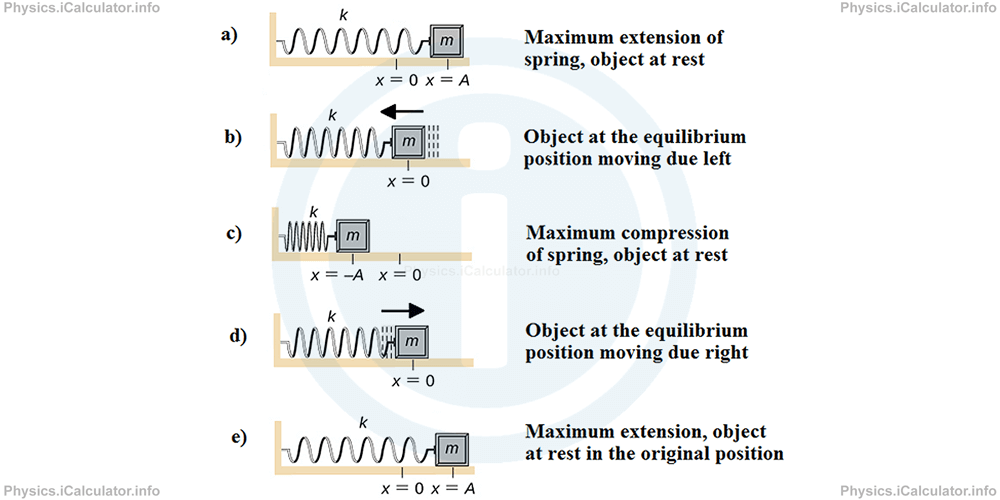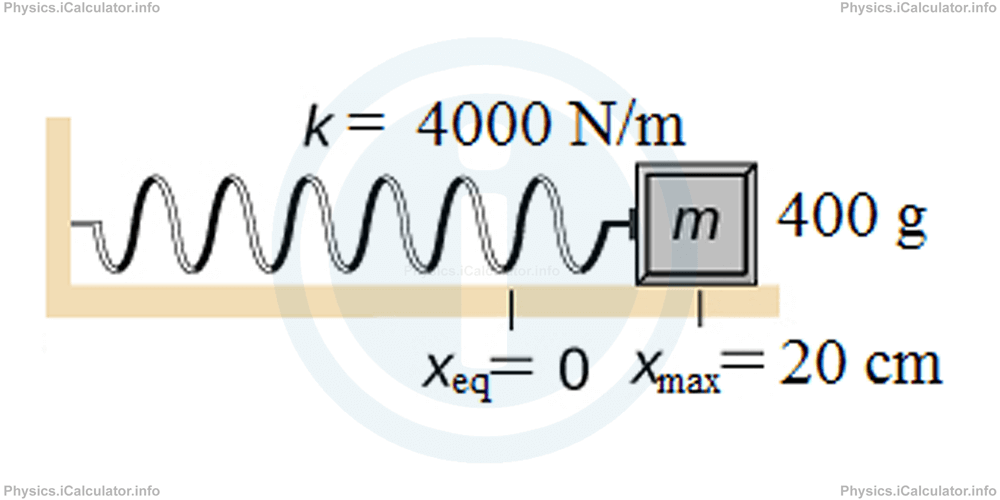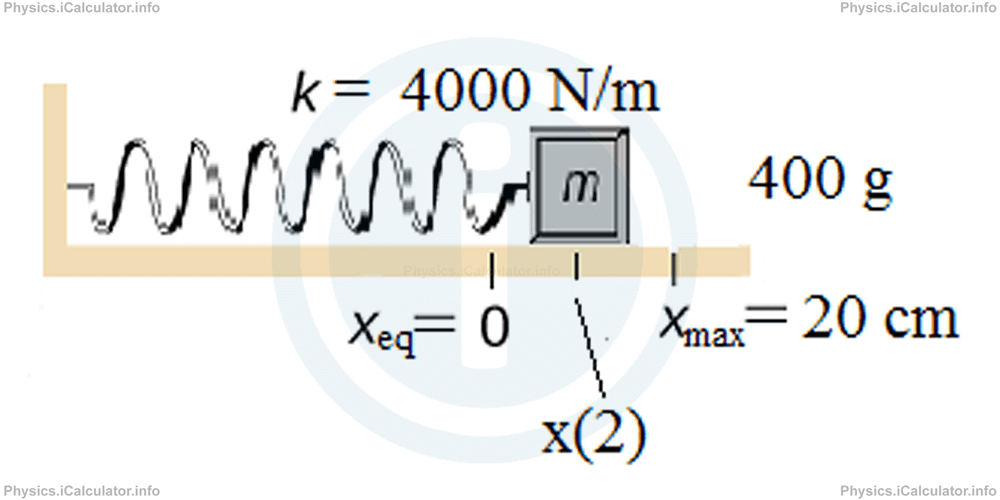Menu
Physics Lesson 10.2.2 - Energy in Simple Harmonic Motion
Please provide a rating, it takes seconds and helps us to keep this resource free for all to use
Welcome to our Physics lesson on Energy in Simple Harmonic Motion, this is the second lesson of our suite of physics lessons covering the topic of Pendulums. Energy in Simple Harmonic Motion, you can find links to the other lessons within this tutorial and access additional physics learning resources below this lesson.
Energy in Simple Harmonic Motion
As stated earlier, sustainable SHM cannot exist without a continuous source of energy. Otherwise, oscillations will dump and eventually they fade away.
Any object or system moving in sustainable SHM possesses two kinds of energy: Kinetic Energy KE and Potential Energy PE. As an example, we can take again an oscillating spring with constant k as shown in the figure.

Again, it is more suitable to use the cosine function to describe oscillations as initially the spring is stretched at maximum. We consider the duration of event very short, so there are no damping in oscillations. Therefore, the equation of this SHM is
where A is the amplitude of oscillation or the maximum distance of the object from the equilibrium position.
As explained in the previous topic, velocity is the first derivative of position in respect to the time. Thus, we obtain for v(t)
We will use these two equations to describe the energy in SHM. As explained in the Physics tutorial "Elastic Potential Energy", the PE of a stretched spring is calculated by the formula
or
= k × A2 × cos2(ω × t + φ)/2
When the spring is at the positions of maximum extension or compression, the system possesses only PE. Furthermore, this PE takes the maximum value, i.e. the cosine part becomes 1. Hence, we have
On the other hand, kinetic energy KE of the oscillating object is calculated by the formula
or
= m × A2 × ω2 × sin2(ω × t + φ)/2
When the object is at the equilibrium position, the spring is neither stretched nor compressed. Thus, its PE = 0 and KE = KEmax. In this case, the sine part of formula becomes 1 and we obtain
We assume the mechanical energy is conserved during a sustainable SHM. Thus, we have
In the first case shown in the above figure (figure a - maximum extension of spring, object at rest), we have
= 0 + PEmax
= k × A2/2
In the second figure (figure b - object and spring at equilibrium position, moving due left at maximum speed), we have
= KEmax + 0
= KEmax
= m × A2 × ω2/2
In the third figure (figure c - maximum compression of spring, object at rest), we have
= 0 + PEmax
= k × (-A)2/2
= k × A2/2
In the fourth figure (figure d- object and spring at equilibrium position, moving due right at maximum speed), we have
= KEmax + 0
= KEmax
= m × A2 × ω2/2
and in the fifth (and last) figure (figure e - maximum extension of spring, object at rest), we have
= 0 + PEmax
= k × (-A)2/2
= k × A2/2
In all the other positions, the mechanical energy of the system is
= m × A2 × ω2 × sin2(ω × t + φ)/2 + k × A2 × cos2(ω × t + φ)/2
Example 1
A 400 g object is attached at the end of a spring of constant 4000 N/m. Initially the spring is stretched by 20 cm and then it is released. As a result, the system object-spring starts performing simple harmonic motion.

Calculate:
- The mechanical energy of the system
- Speed and position of the object at t = 2 s
- Kinetic energy of the object when it is at halfway between the equilibrium position and maximum compression, moving due left
- Potential energy of the spring when it is at 5 cm from equilibrium position moving due right
Solution 1
Clues:
m = 400 k = 0.4 kg
k = 4000 N/m
A = xmax = 20 cm = 0.2 m
a We can calculate the system's ME by finding PEmax as they are equal. Thus,
= k × A2/2
= 4000 × 0.22/2
= 80J
b Now, it is better to use the sine equation
for position and the cosine equation
for the velocity of the object because the object is initially at the maximum extension, i.e. φ = 1/4 of a cycle = 1/4 × 2π = π/2 This means that when t = 0 we have
= A × sin φ
= A × sin π/2
= A × 1
= A
Thus, giving that
ω = √k/m
= √4000/0.4
= √10 000
= 100 rad/s
and
we obtain by substituting the above values:
= 0.2 × sin 201.57
= 0.2 × 0.486
= 0.097 m
= 9.7 cm
This result means the object is 9.7 cm on the right of the equilibrium position as shown in the figure

Also,
v(2) = -0.2 × 100 × cos (100 × 2 + π/2)
= -20 × 0.874
= -17.47 m/s
c We can take x = -10 cm = - 0.1 m as the object is halfway between the equilibrium position and maximum compression. Thus, since the potential energy in this position is
= 4000 × 0.12/2
= 20 J
Hence, the kinetic energy at the given position is
= 80 J - 20J
= 60J
d Now, we have x = 5 cm = 0.05 m for the position. Thus,
= 4000 × 0.052/2
= 5J
You have reached the end of Physics lesson 10.2.2 Energy in Simple Harmonic Motion. There are 5 lessons in this physics tutorial covering Pendulums. Energy in Simple Harmonic Motion, you can access all the lessons from this tutorial below.
More Pendulums. Energy in Simple Harmonic Motion Lessons and Learning Resources
Whats next?
Enjoy the "Energy in Simple Harmonic Motion" physics lesson? People who liked the "Pendulums. Energy in Simple Harmonic Motion lesson found the following resources useful:
- Harmonic Energy Feedback. Helps other - Leave a rating for this harmonic energy (see below)
- Oscillations Physics tutorial: Pendulums. Energy in Simple Harmonic Motion. Read the Pendulums. Energy in Simple Harmonic Motion physics tutorial and build your physics knowledge of Oscillations
- Oscillations Revision Notes: Pendulums. Energy in Simple Harmonic Motion. Print the notes so you can revise the key points covered in the physics tutorial for Pendulums. Energy in Simple Harmonic Motion
- Oscillations Practice Questions: Pendulums. Energy in Simple Harmonic Motion. Test and improve your knowledge of Pendulums. Energy in Simple Harmonic Motion with example questins and answers
- Check your calculations for Oscillations questions with our excellent Oscillations calculators which contain full equations and calculations clearly displayed line by line. See the Oscillations Calculators by iCalculator™ below.
- Continuing learning oscillations - read our next physics tutorial: Simple Harmonic Motion
Help others Learning Physics just like you
Please provide a rating, it takes seconds and helps us to keep this resource free for all to use
We hope you found this Physics lesson "Pendulums. Energy in Simple Harmonic Motion" useful. If you did it would be great if you could spare the time to rate this physics lesson (simply click on the number of stars that match your assessment of this physics learning aide) and/or share on social media, this helps us identify popular tutorials and calculators and expand our free learning resources to support our users around the world have free access to expand their knowledge of physics and other disciplines.